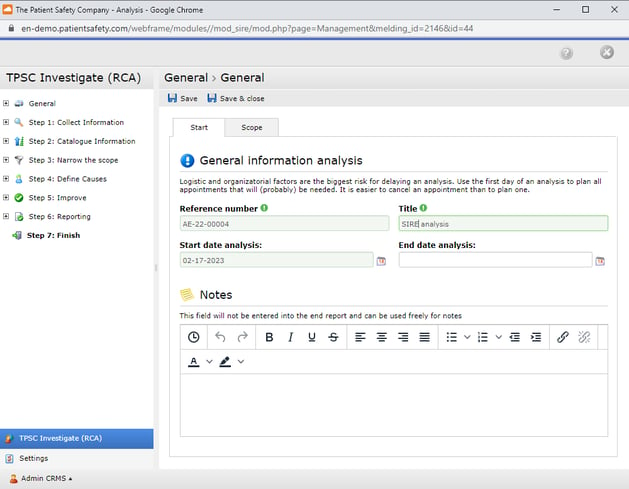The SIRE (Systematic Incident Reconstruction and Evaluation) method is a specialized variant of Root Cause Analysis (RCA). It was developed for use in healthcare, and can help healthcare organizations in uncovering the underlying causes of incidents. There are some key differences between the SIRE methodology and the more generic RCA, however, which we will go into below.
Differences between the Root Cause Analysis and the SIRE Method
Where Root Cause Analysis can be performed in any field where incidents occur and is used more widely across industries, the SIRE method is more specifically used in healthcare.
SIRE places a strong emphasis on understanding the sequence of events that led to the incident and tries to identify any barriers that failed to prevent the incident to uncover the root cause of the incident.
Another main difference is the structure of the investigation process. RCA is more flexible than SIRE, and can vary depending on the individual or organization conducting the investigation. The SIRE method is more rigid in its systematic and structured approach, with a defined process for the documentation and analysis of incidents.
Additionally, RCA can use various tools and methodologies depending on the organization and the industry the investigation is conducted in, while SIRE has its own specific toolset. The SIRE toolset consists mainly of the timeline analysis, the barrier analysis, and the process analysis, which we will now explain further.
The different component parts of the SIRE method
As stated above, the SIRE method contains three different analysis types. The timeline analysis, the barrier analysis, and the process analysis.
The Timeline Analysis
The timeline analysis is used to understand what sequence of events led to the incident. What happened when and how did it ultimately contribute to the incident? This analysis allows organizations to identify specific moments or actions that played a part in the incident.
Creating a timeline like this helps organizations uncover the root causes of incidents and gives insight into the full chain of events that can set off incidents and near-incidents.

The Barrier Analysis
The barrier analysis is used to identify the systems and processes that were meant to prevent the incident from occurring, but failed. This includes identifying any physical, organizational, or human-related barriers that may have failed.
A successful barrier analysis can help organizations identify opportunities for improvement.
The Process Analysis
The process analysis is used to understand the underlying causes of the incident. This includes identifying any issues with procedures, policies, or practices that may have contributed to the incident. Knowing where policies failed or were insufficient can help further prevent future incidents.
By using the three analyses in combination, the SIRE method provides an exhaustive approach to incident investigation that will help organizations in preventing further adverse events.
TPSC Cloud™ and The SIRE method
The TPSC Cloud™ incident management software allows healthcare organizations to easily document and analyze patient safety incidents. Using TPSC Cloud™ in combination with the SIRE method, a clear and concise summary of the incident and its root causes can be created.
During incident investigations with TPSC Cloud™, all parties involved can collaborate and communicate easily. Even when incidents are reported anonymously, the software will ensure that its reporters are made aware of the progression of their reports.

The SIRE method in incident reports in TPSC Cloud™
A SIRE analysis can be started directly from an incident report. In our software, we refer to the SIRE method as TPSC Investigate. Linked to the incident report, a new file is created in which all results of the SIRE analysis are noted and shared with stakeholders.
The SIRE analysis file in TPSC Investigate has a built-in roadmap by which information is gathered, organized and the delineation of the investigation takes place. From the established timeline, a barrier and process analysis are then performed to arrive at the causes of the incident.
There are also additional analysis options available in TPSC Investigate, such as a cause tree or fishbone diagram. From the causes that are identified, improvements are defined and a summary of the findings and improvement measures follows in a final report. This report can then be shared with stakeholders.
Integration of the SIRE methodology with TPSC Improve
TPSC Improve is the solution in which all improvement actions (from different sources) are recorded. Via workflows an improvement action will be submitted to the responsible manager for approval, after which he or she can deploy the tasks to employees involved. After the implementation of an improvement action, results are recorded and an evaluation is planned. After this, an improvement action can be shared in the organization via the lessons learned overview.
The improvement actions identified in the SIRE analysis can be integrated with the TPSC Improve application. This way, the improvement actions from the SIRE analysis become part of the improvement process of the organization and the progress and outcomes are monitored.
Wondering how to deploy TPSC Cloud™ in your organization? Request a free online demo. Would you rather read more about the other analysis methods besides the SIRE method that can be integrated in our software? You can find that information on our data analysis page.

%20(3)%20(1).jpg)


